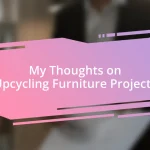Key takeaways:
- Personalization in interior spaces involves using items that reflect your personality and experiences, transforming a generic environment into a meaningful home.
- Choosing colors, styles, and furniture that resonate with your lifestyle and emotions is crucial for creating a cohesive and inviting atmosphere.
- Incorporating personal decor items, textures, and maintaining a unified aesthetic enhance the uniqueness and warmth of your space, making it feel truly yours.

Understanding Personalization Basics
Personalization in interior spaces is about reflecting who you are and what you love. When I first moved into my apartment, I found myself surrounded by generic furniture that didn’t speak to me. It felt more like a showroom than a home, and I realized that true comfort comes from surrounding ourselves with items that resonate with our personality and experiences.
I remember a time when I stumbled upon a vintage globe at a flea market. It sparked memories of my travels and dreams of future adventures. Bringing that piece into my living room not only added character but also became a conversation starter. It’s fascinating how a single object can encapsulate our stories and ignite emotions, making our spaces feel alive and personal.
Have you ever thought about how your favorite colors can set the mood of your space? I adore warm tones because they evoke a sense of warmth and coziness, especially during the winter months. By choosing colors that evoke emotions tied to good memories, I’ve created a sanctuary that feels uniquely mine, proving that personalization goes beyond aesthetics; it’s about creating a narrative that reflects our journey.

Identifying Your Style Preferences
Identifying your style preferences is a deeply personal journey. I often find inspiration in the spaces around me, from cozy cafés to art exhibits. For instance, during a visit to a colorful market in a new city, I was captivated by the vibrant textiles. It triggered an understanding of how much I appreciate bold colors and eclectic patterns, prompting me to incorporate similar elements into my home.
Taking the time to explore different styles and eras can reveal surprising insights into what resonates with you. One afternoon, I flipped through home design magazines, and to my delight, I noticed a recurrent theme: mid-century modern furniture spoke to my sense of simplicity and functional beauty. This exploration allowed me to distill my preferences, helping me curate a space that felt authentic and true to who I am.
Reflecting on your lifestyle is equally essential when identifying your style. For example, I cherish cozy evenings spent reading, so I prioritized creating a warm nook filled with books and soft lighting. Ask yourself what activities you love; your answers will guide you toward a personalized style that aligns with your everyday life.
| Style Option | Description |
|---|---|
| Modern | Sleek lines, minimal decor, and a neutral palette. |
| Bohemian | Eclectic mix of colors, patterns, and global influences. |
| Industrial | Raw materials like wood and metal, often in an open layout. |
| Traditional | Classic furnishings, rich colors, and elegant details. |
| Rustic | Natural elements, textures, and a cozy, comfortable feel. |

Choosing the Right Color Schemes
Choosing the right color scheme can dramatically transform a space, evoking emotions and shaping the overall atmosphere. I recall a time when I decided to paint my home office a soft mint green. It was inspired by a serene lakeside retreat I once visited. The moment I stepped into that room, I felt calm and focused, which was exactly the vibe I aimed to create for my workspace. Colors can pull memories and emotions from us, which is why I believe it’s important to select shades that resonate personally.
Here are some tips I’ve found helpful when choosing colors:
- Consider the Purpose: Different colors serve different purposes. For instance, blue promotes tranquility, while yellow can add cheerfulness.
- Utilize Color Psychology: Colors can influence mood. Warmer tones can evoke comfort, while cooler ones often feel refreshing.
- Test Samples: Always test paint samples on your walls to see how they look in different lighting throughout the day.
- Create a Palette: Pairing colors can enhance your aesthetic. I love combining earthy tones with pops of rich jewel colors for balance.
- Reflect Personal Experiences: Choose colors that remind you of joyful moments, like the sunset on a beach vacation or your favorite autumn leaves.
By immersing myself in the color selection process, I’ve learned to create spaces that truly reflect my emotions and experiences, turning my home into a vibrant tapestry of who I am. Each hue tells a story, and together, they create a narrative that resonates deeply within me.

Selecting Functional Furniture
Selecting functional furniture is an essential step in creating a personalized space that serves both form and function. When I was updating my living room, I found myself drawn to a mid-century modern coffee table that not only looked stunning but also offered storage. It’s incredible how a single piece can streamline your space while still reflecting your style. Have you ever experienced that moment when the right furniture piece just clicks?
I’ve learned that considering scale and proportion is vital for functionality as well. My previous attempts at fitting a large sectional in my smaller living room often left the space feeling cramped. However, once I switched to a smaller, more adaptable sofa with a pull-out bed, my room felt open yet cozy. The transformation was striking, highlighting how functionality can enhance the overall aesthetic of the space. This experience made me more mindful of how each furniture piece relates to its surroundings—it’s a dance of balance and usability.
Finally, it’s crucial to think about the materials and durability of furniture. I remember choosing a durable, easy-to-clean fabric for my dining chairs after a mishap with red wine at a party. Now, not only do the chairs look great, but I can also enjoy gatherings without the stress of potential spills ruining my decor. Selecting the right materials can save you time and anxiety in the long run, making your spaces not only stylish but also livable. How do you approach material choices for your furniture?

Incorporating Personal Decor Items
Incorporating personal decor items into my living space has been one of the most enjoyable aspects of making it feel like home. I remember the joy of finally displaying a collection of vintage postcards from my travels. Each postcard not only adds color to my walls but also serves as a daily reminder of the places I’ve been and the experiences I’ve had. Isn’t it fantastic when art can evoke such strong memories?
Another way I’ve personalized my decor is through family heirlooms. I inherited a beautiful vase from my grandmother that now sits prominently on my dining table. It’s not just a decorative item; it tells a story of love and history. When I invite friends over, it often sparks conversations about family traditions, turning my space into a gathering point for shared memories. What do your cherished items say about you?
I also love to incorporate DIY pieces into my home, adding a unique touch that you won’t find in a store. Like the time I created a colorful wall hanging from fabric scraps; each piece represents a different moment in my life, from concerts to family gatherings. Every time I see it, I’m reminded of the joy of creating something special. Personal touches like these transform a house into a home where every corner is filled with meaning. What personal touches do you cherish in your space?

Using Textures and Patterns
Using textures and patterns is an essential element in transforming my interior spaces—it’s like adding a layer of personality that truly brings the room to life. I recall the thrill of choosing a bold, geometric print for my curtains. The moment they were hung, the entire atmosphere shifted. Have you ever felt such an instant spark from a design choice?
When integrating textures, I’m keen on mixing materials to create visual interest. In my home office, I paired a sleek, modern desk with a chunky knitted throw on my chair. This combination not only feels cozy as I work but also adds depth to the overall look. It’s fascinating how layering different textures can evoke a sense of warmth and comfort. How do you approach adding texture to your spaces?
Patterns also play a significant role in energizing a room. I once experimented with a mix of floral throw pillows and a striped rug; at first, I was nervous about whether it would clash. To my delight, the combination created a vibrant, inviting space that reflected my quirky style. Has a bold design choice ever surprised you? For me, it’s these unique pairings that make my home feel more eclectic and alive.

Maintaining a Cohesive Look
Maintaining a cohesive look in my home has often felt like an art form—a delicate balance that ties everything together. I remember when I finally committed to a color palette for my living room; shades of blue and earthy tones connected my furniture and decor seamlessly. This insight has taught me that a consistent color scheme can create harmony in any space. How do you choose colors that resonate with you?
Beyond color, I find that consistent styles also contribute to that unified feel. While designing my bedroom, I decided to stick with a rustic aesthetic, featuring reclaimed wood furniture alongside soft linens. This not only established a serene atmosphere but also enforced a strong identity for the room. Have you experienced how a specific style can influence your mood? I’ve noticed that when my decor speaks the same language, I feel more at peace in my surroundings.
Finally, I am a firm believer in limiting the number of decorative elements. Initially, I wanted to showcase everything I loved, but I quickly learned that less is often more. I recall clearing out clutter from a shelf that once felt overcrowded, allowing the few cherished pieces to shine. It transformed the entire display into a focal point of my room. What items do you have that deserve to stand out? I’ve come to treasure those moments of simplicity that allow my favorite pieces to breathe and tell their own stories.














